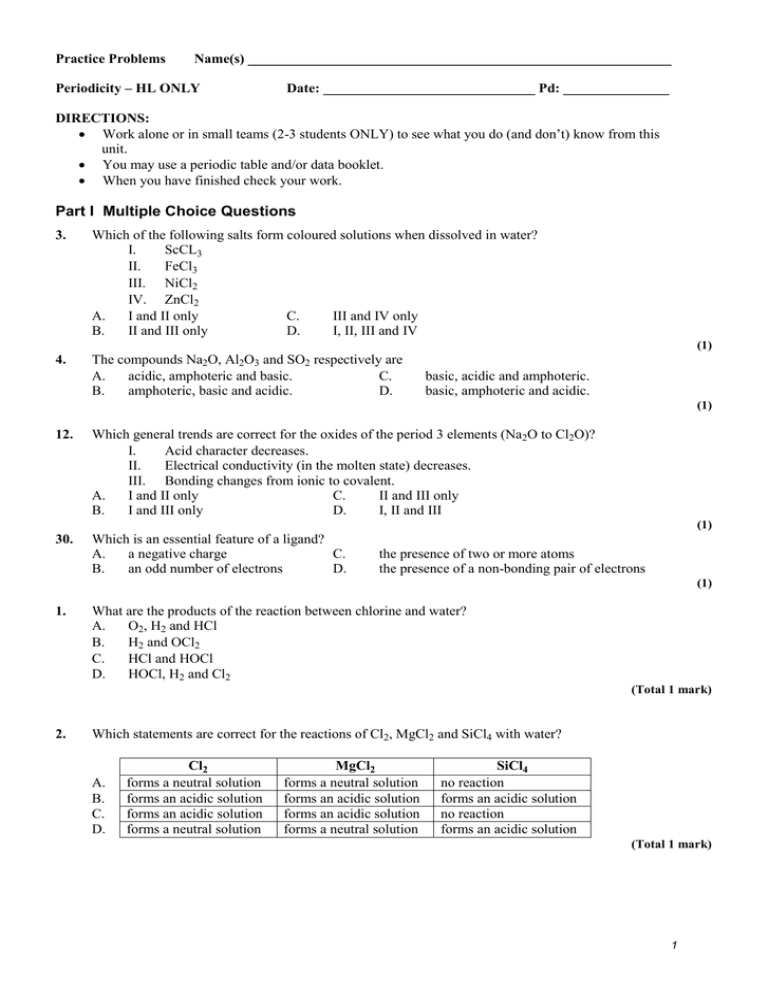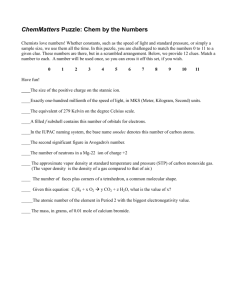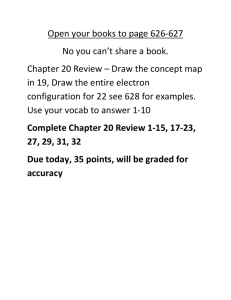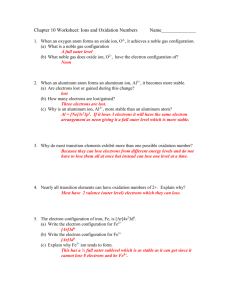1 - Teacher Pages
advertisement

Practice Problems Name(s) ____________________________________________________________ Periodicity – HL ONLY Date: ______________________________ Pd: _______________ DIRECTIONS: Work alone or in small teams (2-3 students ONLY) to see what you do (and don’t) know from this unit. You may use a periodic table and/or data booklet. When you have finished check your work. Part I Multiple Choice Questions 3. Which of the following salts form coloured solutions when dissolved in water? I. ScCL3 II. FeCl3 III. NiCl2 IV. ZnCl2 A. I and II only C. III and IV only B. II and III only D. I, II, III and IV (1) 4. The compounds Na2O, Al2O3 and SO2 respectively are A. acidic, amphoteric and basic. C. B. amphoteric, basic and acidic. D. basic, acidic and amphoteric. basic, amphoteric and acidic. (1) 12. Which general trends are correct for the oxides of the period 3 elements (Na2O to Cl2O)? I. Acid character decreases. II. Electrical conductivity (in the molten state) decreases. III. Bonding changes from ionic to covalent. A. I and II only C. II and III only B. I and III only D. I, II and III 30. Which is an essential feature of a ligand? A. a negative charge C. B. an odd number of electrons D. (1) the presence of two or more atoms the presence of a non-bonding pair of electrons (1) 1. What are the products of the reaction between chlorine and water? A. O2, H2 and HCl B. H2 and OCl2 C. HCl and HOCl D. HOCl, H2 and Cl2 (Total 1 mark) 2. Which statements are correct for the reactions of Cl2, MgCl2 and SiCl4 with water? A. B. C. D. Cl2 forms a neutral solution forms an acidic solution forms an acidic solution forms a neutral solution MgCl2 forms a neutral solution forms an acidic solution forms an acidic solution forms a neutral solution SiCl4 no reaction forms an acidic solution no reaction forms an acidic solution (Total 1 mark) 1 4. Which statements are correct for the complex ion [CuCl4]2–? I. The oxidation number of Cu in the complex ion is +2. II. The coordination number of the copper ion is 4. III. Chloride ions are behaving as ligands. A. I and II only B. I and III only C. II and III only D. I, II and III (Total 1 mark) 7. Which combination is correct for the complex ion in [Co(NH3)4(H2O)Cl]Br? Overall charge of the Oxidation state of cobalt Shape of the complex ion complex ion A. +2 Octahedral +2 B. +3 Octahedral –1 C. +2 Octahedral +1 D. +2 Tetrahedral +1 (Total 1 mark) 10. Which process is responsible for the colour of a transition metal complex? A. The absorption of light when electrons move between s orbitals and d orbitals B. The emission of light when electrons move between s orbitals and d orbitals C. The absorption of light when electrons move between different d orbitals D. The emission of light when electrons move between different d orbitals (Total 1 mark) 12. Which transition element, or compound of a transition element, is used as a catalyst in the Contact process? A. Fe B. MnO2 C. V2O5 D. Ni (Total 1 mark) 2 Short Response Questions 13. Outline the reasoning for the following in terms of electronic configuration: (ii) V3+(aq) is coloured and can behave as a reducing agent (easily loses electrons), whereas Zn2+(aq) is not coloured and does not behave as a reducing agent (easily loses electrons). ..................................................................................................................................... ..................................................................................................................................... ..................................................................................................................................... ..................................................................................................................................... ..................................................................................................................................... ..................................................................................................................................... ..................................................................................................................................... (6) (Total 8 marks) 14. Define the term ligand. Cu2+(aq) reacts with ammonia to form the complex ion [Cu(NH3)4]2+. Explain this reaction in terms of an acid-base theory, and outline the bonding in the complex ion formed between Cu2+ and NH3. ................................................................................................................................................ ................................................................................................................................................ ................................................................................................................................................ ................................................................................................................................................ ................................................................................................................................................ ................................................................................................................................................ ................................................................................................................................................ ................................................................................................................................................ ................................................................................................................................................ ................................................................................................................................................ (Total 4 marks) 23. Elements with atomic number 21 to 30 are d-block elements. (a) Identify which of these elements are not considered to be typical transition elements. ..................................................................................................................................... ..................................................................................................................................... (1) (b) Complex ions consist of a central metal ion surrounded by ligands. Define the term ligand. ..................................................................................................................................... ..................................................................................................................................... ..................................................................................................................................... (c) Complete the table below to show the oxidation state of the transition element. (2) (3) ion oxidation state (d) Cr2O72– [CuCl4] 2− [Fe(H2O)6] 3+ Identify two transition elements used as catalysts in industrial processes, stating the process in each case. ..................................................................................................................................... ..................................................................................................................................... ..................................................................................................................................... ..................................................................................................................................... (2) (e) Apart from the formation of complex ions and apart from their use as catalysts, state two other properties of transition elements. ..................................................................................................................................... ..................................................................................................................................... 3 (2) (Total 10 marks) 28. (a) Classify each of the following oxides as acidic, basic or amphoteric. (i) aluminium oxide …………………………………………………………………………………… (1) (ii) sodium oxide …………………………………………………………………………………… (iii) sulfur dioxide …………………………………………………………………………………… (1) (1) (b) Write an equation for each reaction between water and (i) sodium oxide …………………………………………………………………………………… …………………………………………………………………………………… (ii) sulfur dioxide. …………………………………………………………………………………… …………………………………………………………………………………… (1) (1) (Total 5 marks) 33. By reference to the structure and bonding in the compounds NaCl and SiCl4 (i) state and explain the differences in conductivity in the liquid state. ..................................................................................................................................... ..................................................................................................................................... ..................................................................................................................................... ..................................................................................................................................... (3) (ii) predict an approximate pH value for a solution formed by adding each compound separately to water. ..................................................................................................................................... ..................................................................................................................................... ..................................................................................................................................... ..................................................................................................................................... ..................................................................................................................................... ..................................................................................................................................... (4) (Total 7 marks) 4 Practice Problems for Periodicity Objectives – ANSWER KEY Multiple Choice Questions – 1 point each [14 points total] 3. 4. 12. 30. 1. 2. 4. 7. 10. 12. B D C D C B D C C C Short Response Questions [6] 13. (i) (ii) 2 2 1 Mg: 3s and Al: 3s 3p (need both for mark); 3p electron is higher in energy than 3s (and easier to remove); 2 3+ 3 2+ 10 V : [Ar]3d and Zn : [Ar] 3d (need both for mark); colour due to splitting of partially filled d orbitals (at different energy levels); electronic transitions between these are responsible for colour; V3+ has partially filled d orbitals / Zn2+ does not; V3+ not in its highest oxidation state (and can be oxidized); Zn2+ in its highest oxidation state (and cannot be further oxidized); 6 [8] 14. ligand: a molecule or ion that can bond to a (central) metal ion (to form a complex); NH3: Lewis base and Cu2+: Lewis acid (need both for mark); each NH3 / ligand donates an electron pair (to Cu2+); forming coordinate covalent / dative covalent bond; 4 (a) 1 [4] 23. (b) scandium and zinc / Sc and Zn; Both needed for the mark. Accept copper/Cu if given in addition to Sc and Zn i.e. all three needed for the mark. species / neutral molecules / anions which contain a non-bonding pair of electrons; able to form coordinate/dative covalent bonds; 2 (c) Cr2O72− 2[CuCl4]2− [Fe(H2O)6]3+ oxidation state +6 +2 +3 Accept 6+, 2+, 3+. If given as 6, 2, 3 or (VI), (II), (III), Award [2] only. V / V2O5 in the contact process; Fe in the Haber process; Ni in the conversion of alkenes to alkanes / hydrogenation reactions; Award [1] each for any two. Accept any other suitable examples. variable oxidation states; coloured compounds; Accept any other suitable examples. ion (d) (e) 3 2 max 2 [10] 28. (a) (i) (ii) (iii) aluminium oxide amphoteric; sodium oxide basic; sulfur dioxide acidic; 3 5 (b) (i) (ii) Na2O + H2O → 2Na+ + 2OH−; SO2 + H2O → H2SO3; Accept NaOH and H+ + HSO3– / 2H+ + SO 2 2 3 . [5] 32. (i) (ii) (iii) metallic bonding in Na and Mg; more delocalized (OWTTE) electrons in Mg / Mg ion is smaller /more positive; stronger attraction in Mg between positive ions and delocalized electrons; Si is macromolecular / a giant molecule / OWTTE; many (covalent) bonds to be broken; A clear implication of covalent bonding must be made if both marks are to be awarded. van der Waals’ / weak intermolecular forces / London dispersion forces; Cl2 has more electrons / higher Mr than Ar; 3 2 2 [7] 33. (i) (ii) NaCl conducts and SiCl4 does not; NaCl ionic and SiCl4 covalent; ions can move in liquid (in NaCl) / OWTTE; NaCl pH = 7; salt of strong acid and strong base / Na+ and Cl− not hydrolysed; SiCl4 pH = 0 to 3; HCl is formed / strong acid formed; 3 4 [7] 6








